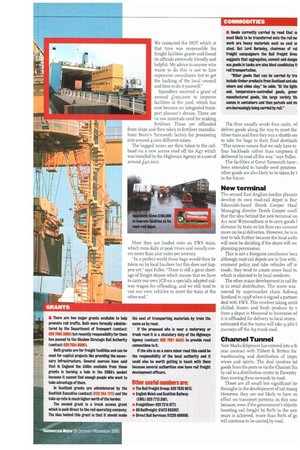Rail can be an efficient method of carrying freight—but that
Page 34

Page 35

If you've noticed an error in this article please click here to report it so we can fix it.
does not mean haulage has to lose out. The two modes of transport can work together
admirably and, as Mike Sherrington discovered, government grants are
available for operators who want to capitalise on train power...
Letting the train take the strain is becoming increasingly popular among East Anglian road hauliers with at least two firms either having, or planning, their own rail-road depots. The most significant steps have been taken by Great Yarmouth. based Spandler Brothers, which has been established in Norfolk for more than roo years. It currently runs a fleet of 40 tractive units and 8o trailers with depots at Great Yarmouth and Montrose in Scotland. Spancllers makes runs to the Continent and Ireland as well as carrying out domestic work and being part of the Weaver Pallet Network.
However, its biggest challenge came when it was given a contract by its parent company, fertiliser manufacturer ASET Bunn, to move roo,000 tonnes of fertiliser to various destinations in the United Kingdom.
Rail sidings
John Fuller, who masterminded the operation for Bunn/Spandlers, explains: "We had access to rail sidings which were previously used for cleaning the holiday trains which regularly used to visit Great Yarmouth. So as an experiment we contacted rail-freight firm EWS to see if we could run a trial train carrying fen tiliser. This operation made rather a mess of the siding so we started to look at what grants we could get to make things more permanent.
We contacted the DOT which at that time was responsible for freight facilities grants and found its officials extremely friendly and helpful. My advice to anyone who wants to do this is not to hire expensive consultants but to get the backing of the local council and then to do it yourself.
Spandlers received a grant of around Doo,000 to improve facilities at the yard, which has now become an integrated transport planner's dream. There are so raw materials used for making fertiliser. These are offloaded from ships and then taken to fertiliser manufacturer Bunn's Yarmouth factory for processing into around 4,000 different mixes.
The bagged mixes are then taken to the railhead via a new access road off the A47 which was installed by the Highways Agency at a cost of around f40, oo o.
Here they are loaded onto an EWS train, which runs daily at peak times and usually covers more than zoo miles per journey.
"In a perfect world these bags would then be taken on by local hauliers but this does not happen yet," says Fuller. "There is still a great shortage of freight depots which means that we have to carry our own J CB on a specially adapted railway wagon for offloading, and we still tend to use our own vehicles to meet the train at the other end." The firm usually sends four units, wl deliver goods along the way to meet the tiliser train and then they run a shuttle sec to take the bags to their final destinatil "This system means that we only have to four backloacts rather than umpteen if delivered by road all the way," says Fuller.
The facilities at Great Yarmouth have been extended to handle seed potatoes other goods are also likely to be taken by t in the future.
New terminal
The second East Anglian haulier plannin develop its own road-rail depot is Bur, Edmunds-based Derek Cooper Haul Managing director Derek Cooper con fi that the idea behind the new terminal on An near Wymondham is to carry goods I distance by train so his firm can concent more on local deliveries. However, he is re tant to talk further because the local authc will soon be deciding if the depot will rec planning permission.
This is not a foregone conclusion beca although road-rail depots are in line with ; emment policy and take vehicles off tr roads, they tend to create more local tr; which is objected to by local residents.
The other major development in rail fre is in retail distribution. The move was neered by supermarket chain Safeway Scotland in 1998 when it signed a partnen deal with EWS. This involves taking ambi chilled, frozen and fresh produce by it from a depot in Mossend to Inverness wl it is offloaded for delivery to local stores. estimated that the trains will take 9,36o 1, journeys off the A9 trunk road.
Channel Tunnel
Nov, Marks &Spenter has entered into a th year contract with Tibbett & Britten for warehousing and distribution of impo wines and spirits. The deal involves tel goods from the ports or via the Channel Tui by rail to a distribution centre in Daventry then moving them onwards by road.
These are all small but significant bro throughs in the development of rail transE However, they are not likely to have m effect on transport patterns in this cott because, even if the government's objectiv boosting rail freight by 8o% in the nex years is achieved, more than 8o% of go will continue to be card ect by road.












































































































